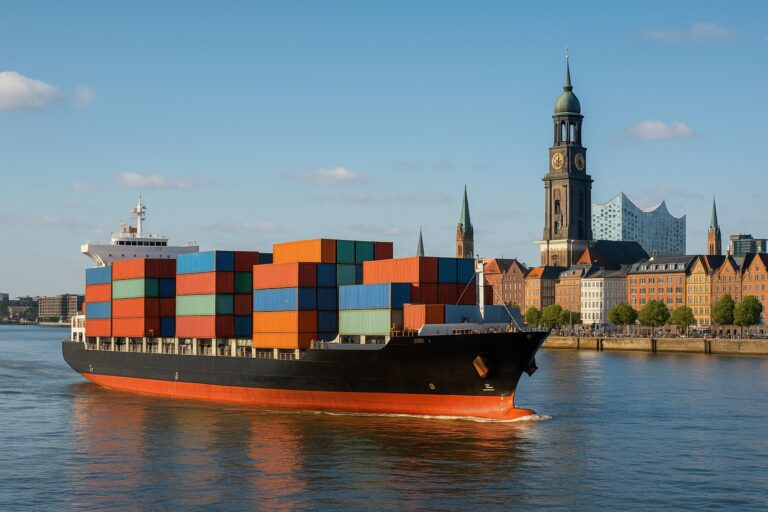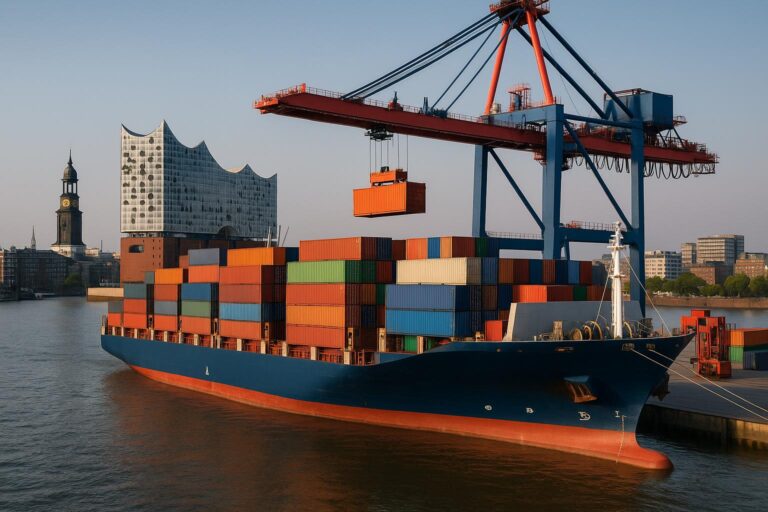Why Shipping Containers from China to Germany Matters in 2025
Shipping containers from China to Germany continues to play a critical role in global trade. With Germany being one of the largest importers of Chinese machinery, electronics, and consumer goods, the demand for reliable container shipping services remains high. Whether you’re a large enterprise or a small importer, understanding container shipping costs, transit times, and the different shipping methods available can help you optimize your logistics strategy.
In this guide, we’ll explore the 20ft and 40ft container shipping costs, outline the key factors that affect international shipping prices, and provide detailed insights into sea freight, rail freight, and door-to-door delivery options to Germany.

Understanding Container Types and Shipping Methods
When shipping goods from China to Germany, selecting the right container and shipping method is crucial to managing your total shipping cost and ensuring safe delivery. The two most commonly used options are the 20ft and 40ft containers, each offering different capacities suitable for varying cargo volumes.
20ft vs. 40ft Containers
A 20ft container (standard dry container) is ideal for small to medium-sized shipments, typically accommodating up to 28 CBM or approximately 10 standard pallets. On the other hand, a 40ft container offers nearly double the capacity (around 58 CBM), making it more cost-effective for bulk cargo or high-volume shipments.
Container Type | Internal Volume | Typical Use Case | Cost Efficiency |
|---|---|---|---|
20ft Container | ~28 CBM | Small machinery, furniture, mixed goods | Best for low-volume loads |
40ft Container | ~58 CBM | Large equipment, textiles, bulk cargo | Cost-effective per CBM |
Choosing the right container load—whether full container load (FCL) or less than container load (LCL)—depends on your cargo size, delivery urgency, and budget.
Sea Freight vs Rail Freight vs Multimodal Shipping
Sea freight remains the most popular and cost-effective shipping method. It is ideal for non-urgent and heavy goods, with flexible scheduling and widespread port coverage.
Rail freight from China to Germany, via the China-Europe Railway Express, offers a faster transit time (as short as 15–18 days) and is often chosen for time-sensitive but cost-conscious shipments.
Multimodal options combine sea or rail with door-to-door delivery, optimizing both cost and time.
Common Shipping Methods
Shipping Method | Transit Time | Cost Range (20ft) | Key Benefits |
|---|---|---|---|
Ocean Freight (FCL) | 28–40 days | $800–$1,200 | Low cost per unit, high volume |
Ocean Freight (LCL) | 30–45 days | $40–$80/CBM | Affordable for small shipments |
Rail Freight (FCL) | 15–20 days | $1,500–$2,000 | Faster than sea, reliable route |
Rail Freight (LCL) | 18–24 days | $60–$100/CBM | Quick and flexible consolidation |
By comparing these different shipping methods, businesses can identify the cost-effective option that aligns with their supply chain needs. The right choice depends on factors like shipping distance, cargo value, urgency, and customs complexity.
Container Shipping Rates from China to Germany
Understanding the container shipping rates from China to Germany is essential for planning your logistics budget. These rates vary based on container size, origin port, destination port, fuel surcharges, and seasonal demand. The total shipping cost includes not only freight charges but also additional expenses like terminal handling, documentation, customs clearance, and transportation costs at the destination.
Average Sea Freight Rates (2025 Estimates)
Route | 20ft Container | 40ft Container | Transit Time | Shipping Method |
|---|---|---|---|---|
Shanghai → Hamburg | $850 | $1650 | 30–35 days | Ocean Freight (FCL) |
Ningbo → Bremerhaven | $880 | $1680 | 32–38 days | Ocean Freight (FCL) |
Qingdao → Hamburg | $700 | $1,580 | 30–40 days | Ocean Freight (FCL) |
Shenzhen → Hamburg | $920 | $1,720 | 28–36 days | Ocean Freight (FCL) |
Tianjin → Hamburg | $790 | $1,570 | 32–42 days | Ocean Freight (FCL) |
Xiamen → Bremerhaven | $870 | $1,660 | 31–39 days | Ocean Freight (FCL) |
Guangzhou → Hamburg | $810 | $1,700 | 29–36 days | Ocean Freight (FCL) |
Dalian → Bremerhaven | $840 | $1,630 | 33–43 days | Ocean Freight (FCL) |
Zhongshan → Hamburg | $890 | $1,710 | 30–37 days | Ocean Freight (FCL) |
Nansha → Bremerhaven | $900 | $1,720 | 30–38 days | Ocean Freight (FCL) |
Note: These are estimated base freight costs. Final shipping prices may vary depending on cargo type, container availability, seasonal fluctuations, and surcharges.
Prices fluctuate monthly and can be affected by factors like:
Port congestion in Europe or China
High fuel prices or bunker adjustment factors (BAF)
Carrier surcharges (e.g. peak season surcharge)
Container availability and shipping line schedule
LCL (Less than Container Load) shipments are calculated by volume (CBM) and often range from $40–$80 per CBM. While LCL is economical for smaller shipments, FCL provides better value per unit for bulk cargo.
Rail Freight Costs to Germany
If you’re considering rail freight via the China-Europe Railway, expect a premium over sea freight but with faster delivery times.
Route | 20ft Container | 40ft Container | Transit Time |
|---|---|---|---|
Chengdu → Duisburg | $2,200 | $2,950 | 15–20 days |
Xi’an → Hamburg | $2,150 | $2,880 | 16–22 days |
Chongqing → Munich | $2,300 | $3,000 | 18–24 days |
Rail freight offers a cost-effective delivery solution for medium urgency goods, especially for electronics, automotive parts, and high value goods where timing is critical but air freight is too costly.
What’s Included in the Shipping Price?
The shipping price usually includes:
Basic freight (port to port)
Origin charges: loading, documentation
Destination charges: unloading, customs clearance
Optional: cargo insurance, inland delivery
Always confirm whether you’re paying port-to-port, door-to-port, or door-to-door shipping. The total shipping cost may also depend on final destination and inland transportation distance within Germany.
You may be interested:
Cost of Shipping 20ft & 40ft Containers from China to UAE
20ft & 40ft Container Shipping Costs from China to Saudi Arabia
20ft & 40ft Container Shipping Costs from China to Cyprus
Shipping Costs for 20ft & 40ft Containers from China to Russia

Transit Times and Shipping Routes from China to Germany
Selecting the right shipping route and understanding the estimated transit time can significantly impact your supply chain efficiency. Whether shipping by sea freight, rail freight, or a multimodal solution, importers must consider both the shipping process and the logistical path to avoid delays and unexpected logistics costs.
Estimated Transit Times by Shipping Mode
Shipping Mode | Estimated Transit Time | Best Use Case |
|---|---|---|
Sea Freight (FCL) | 28–40 days | Bulk or non-urgent cargo |
Sea Freight (LCL) | 30–45 days | Small, mixed cargo |
Rail Freight | 15–24 days | Time-sensitive goods |
Multimodal (Sea + Truck) | 35–50 days | Remote final destinations |
Door to Door Shipping | 30–42 days | End-to-end delivery convenience |
Ocean freight routes often pass through the Suez Canal and Northern Europe, ending at major ports like Hamburg or Bremerhaven. From there, cargo is distributed across Germany and Europe by truck or rail.
Common Shipping Routes from China to Germany
Popular origin ports in China include:
Shanghai – largest outbound volume
Shenzhen (Yantian Port) – ideal for electronics and high-value goods
Ningbo – popular for textiles and consumer products
Qingdao – heavy machinery and industrial goods
These connect with German ports such as:
Hamburg – Germany’s largest and busiest port
Bremerhaven – efficient customs clearance and container handling
Duisburg – key rail freight hub for the China-Europe Railway
For international shipments requiring inland delivery in Germany, it’s common to use rail or truck from the port to cities like Berlin, Munich, Frankfurt, or Stuttgart.
The Shipping Process Explained
A typical container shipping process from China to Germany includes:
Export customs clearance in China
Container loading and shipping from the origin port
Ocean or rail transit to Germany
German customs clearance upon arrival
Inland transportation to the final destination
Proper planning helps ensure smooth shipping, avoid higher shipping costs, and maintain predictable timelines for international trade.
Customs Clearance in Germany: What You Need to Know
When shipping containers from China to Germany, navigating the customs clearance process is a vital part of the international shipping journey. Failing to prepare the correct documents or comply with import regulations can lead to costly delays and even cargo holds.
Required Documents for Customs Clearance
To ensure smooth customs clearance, make sure you provide the following documents:
Commercial Invoice – must clearly state the value, HS codes, and description of goods
Packing List – itemizing the contents of each container
Bill of Lading – issued by the shipping line as proof of cargo carriage
Import License – required for regulated items (e.g., electronics, chemicals)
Certificates of Origin or Conformity – depending on product type
Working with a customs broker or a professional freight forwarder can help you navigate these requirements accurately.
Import Duties and Taxes in Germany
Germany, as part of the EU, imposes the following charges on imports from China:
Import Duties – based on the HS code and customs value
VAT (Value Added Tax) – currently 19% in Germany, applied on CIF (Cost + Insurance + Freight) value
Excise Duties – for specific goods like alcohol, tobacco, and fuel
Importers should also account for additional costs such as port handling fees, customs inspection charges, and possible delays due to document errors.
Role of Freight Forwarders in Customs Compliance
A reliable freight forwarder can coordinate the entire customs clearance process on your behalf, ensuring accurate documentation, timely filing, and communication with German customs authorities.
Some forwarders also offer Delivered Duty Paid (DDP) solutions, where they handle all import taxes and compliance in exchange for a fixed cost. This model is especially useful for eCommerce sellers or new importers seeking simplified logistics.
By partnering with experts, you can avoid compliance risks, minimize delays, and focus on your core business instead of tangled paperwork.
Additional Costs and Cost-Saving Tips
While container rates form the core of your shipping costs, importers often overlook the many additional costs that can impact their total cost of shipping. Understanding these hidden charges is essential for accurate budgeting and profit planning.
Common Additional Shipping Costs
Beyond the base container shipping rates, here are other charges to expect:
Terminal Handling Charges (THC) – at both origin and destination ports
Documentation Fees – for bills of lading, certificates, or customs papers
Inland Haulage Fees – to deliver goods from port to your warehouse
Storage or Demurrage Fees – for delayed clearance or pickup
Cargo Insurance – optional but recommended for high value shipments
Customs Inspection Fees – if goods are flagged by German customs
These logistics costs can add 10–25% to your base rate, especially if you opt for door shipping or door to door delivery services.
Cost-Saving Strategies for Importers
To reduce your overall expenses and secure a cost effective delivery, consider the following:
Ship during off-peak seasons: Avoid Q4 (September–December) when rates spike.
Consolidate shipments: Use LCL or group cargo with trusted partners to save on small loads.
Choose the right freight forwarder: A reliable freight forwarder will help optimize routing, avoid delays, and secure competitive pricing.
Use nearby ports: Selecting a closer destination port can reduce transportation costs within Germany.
Request DDP service: For all-inclusive cost effective solutions, DDP shipping simplifies budgeting by covering taxes and customs under a fixed price.
A strategic approach not only cuts down higher shipping costs, but also improves delivery speed, operational efficiency, and customer satisfaction.

Frequently Asked Questions (FAQs)
How much does it cost to ship a 20ft container from China to Germany?
As of 2025, the average 20ft container transport cost from major Chinese ports like Shanghai or Shenzhen to Hamburg ranges from $700 to $1,120, depending on the season, container availability, and fuel surcharges.
What is the average shipping time from China to Germany by sea?
Sea freight typically takes 28 to 40 days for port-to-port delivery, depending on the origin and destination ports. Door-to-door shipping may add 5–7 days for inland transport and customs clearance.
What is included in the container shipping cost?
A standard container shipping rate includes basic ocean freight, export documentation, and terminal handling. However, additional costs such as cargo insurance, import VAT, customs duties, and inland haulage may apply.
Is rail freight faster than sea freight to Germany?
Yes. Rail freight from cities like Xi’an or Chengdu to German hubs like Duisburg or Hamburg typically takes 15–20 days, offering a good balance between cost and speed for high-value goods.
Do I need a customs broker to import to Germany?
While not mandatory, working with a customs broker or freight forwarder helps ensure smooth customs clearance, especially for new importers or complex shipments.
Can I ship door to door from China to Germany?
Absolutely. Many professional freight forwarders offer door to door shipping services, combining ocean or rail freight with inland truck delivery and full customs handling.
Is cargo insurance necessary for container shipping?
Though optional, cargo insurance is strongly recommended—especially for high-value or fragile shipments—to protect against damage, theft, or delay during transit.
Which is the most cost-effective shipping method from China to Germany?
For bulk cargo, FCL sea freight is the most cost-effective solution. For faster delivery at moderate cost, rail freight is ideal. For small shipments, LCL is budget-friendly.
Are there peak seasons for shipping to Germany?
Yes. Peak seasons (like September–December) see higher shipping costs due to demand. It’s advisable to plan early or ship during off-peak months to save costs.
Which ports in Germany handle most container imports?
Hamburg and Bremerhaven are the busiest container ports in Germany, with efficient handling, customs facilities, and inland rail connectivity.
Final Thoughts: Simplify Your Shipping to Germany
Whether you’re shipping small batches of electronics or full loads of industrial goods, understanding the container shipping process from China to Germany gives you the power to control costs, plan deliveries, and reduce risk. From choosing the right shipping method and container size, to estimating your total shipping cost, to managing customs clearance—each step plays a critical role in your supply chain.
If you’re navigating the complexities of shipping goods internationally, working with experienced freight forwarders can make all the difference. A professional freight forwarder doesn’t just book space on a ship—they act as your logistics partner, helping you:
Select the best route and shipping company
Manage paperwork, taxes, and customs clearance
Arrange door to door shipping and inland delivery
Provide tracking, support, and post-arrival follow-ups
At Tonlexing, we offer tailored container shipping services for 20ft and 40ft loads—by sea, rail, and even multimodal options. Whether you’re a seasoned importer or just starting out, our team can provide a cost-effective, compliant, and hassle-free shipping experience.
Ready to Ship from China to Germany?
Contact us today to:
Get a free shipping quote
Compare FCL vs LCL rates
Explore rail, sea, and door-to-door shipping options
Ensure a smooth, stress-free delivery process


